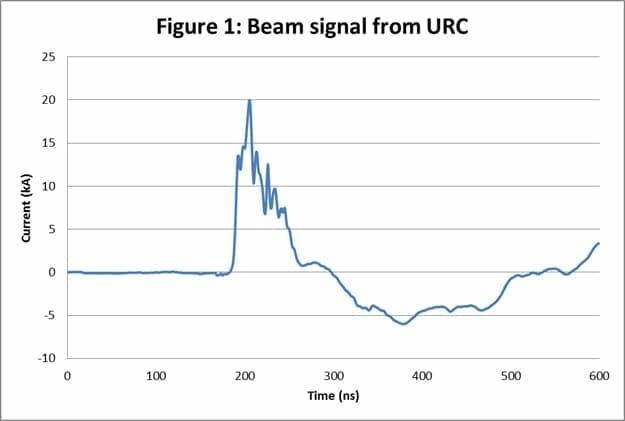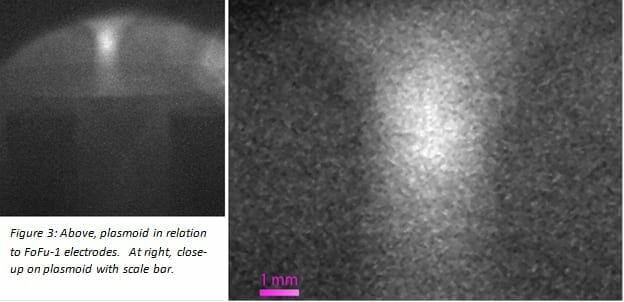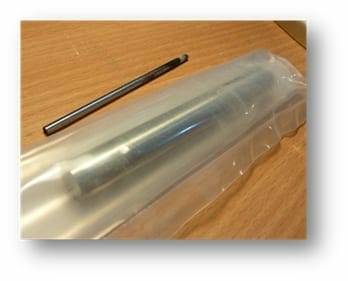Summary
- In an eventful January in the lab, we have seen evidence for the first time that we have achieved high efficiency of energy transfer into the plasmoid and the beam. More than 15% of total bank energy, over 8 kJ, passed through to the beams.
- We have made the highest-resolution images ever of a DPF plasmoid and hit a new record of 180 keV in confined ion energy.
- We have achieved a much better understanding of the sequence of events that leads to the too-low density plasmoids we have been observing.
- Design work has been completed for our ruggedized switches, and manufacture of the test switch is underway.
High energy efficiency demonstrated by first ion beam measurement
This month, we produced strong evidence that we have succeed in transferring a large part (at least 15%) of total input energy into the plasmoid and from there into the beams. The first part of the evidence came from our first observation yet of the ion beam with the upper and lower Rogowski coils (URC and LRC). Like our main Rogowski coils, the URC and LRC produce a signal by induction when a current passes inside their loop. Both are located in a drift tube that extends downward from the main vacuum chamber, with the URC being 31 cm and the LRC 115 cm from the end of the anode, where the plasmoid forms.
On January 12, with shot 01121103, we saw a clear and very large signal from the URC, which records the rate of change of the current. Integrating this signal, we got a measurement of the current in the ion beam (Figure 1), which peaked at 20 kA and lasted (full-width at half maximum) 36 ns. This signal had an excellent signal-to-noise ratio and was far larger than we had seen before.

We used the delay between the ion beam and the electron beam to estimate the average energy of the ions in the beam, which turns out to be extremely high—5.5 Mev, about five times as high as predicted by our theory. The energy contained in the beam is therefore also quite high—4.6 kJ. Since equal energy must be transferred to the e-beam, at least before it exits the plasmoid, the total energy in the beams would then be around 9 kJ.
To see how efficient this energy transfer into the beam is, we consider that in this shot, 10 capacitors were charged to 33 kV, so they released a total of 51 kJ. By the time of the pinch, 63% of this energy, 32 kJ, had been transferred into the plasma, about half into the magnetic field and half into the kinetic energy of the plasma. So, about 28% of the available energy at the time of the pinch was transferred into the beam. We have some confirmation of this from the current trace itself, (Figure 2), since by the time the beam was over, the current had declined by 17%. This works out to a 30% decline in energy. (More confirmation of this energy transfer is below in the next section.)

This beam shot, while only one shot, tells us some other important things. First, it reveals that the bump into the current is actually an early electron beam arriving at the anode. A later beam, as in the short-pinch-time shots (SPTs), would get buried either in the very sharp decline of the current later in the pinch or in the rebound after that. So, we now know this is a beam, not a shock. Such an early powerful beam will also drain the plasmoid of most of its energy, preventing further contraction and the achievement of the expected density.
Second, it shows that, at least at 30 cm from the plasmoid, the ion beam has not been neutralized by an electron current. This is important for our plans to get energy out of the beam by an inductive coil.
Third, it shows that the beam can be relatively narrow. For the beam to fit entirely within the URC, which is only 3 cm in radius, it can have a half-opening angle of no more than about 6 degrees, about what other researchers have reported for a non-collimated beam. The beam, we believe, did not hit the LRC, but rather the side of the drift tube. The LRC signal was also larger than what we have seen in the past, but it started with a negative electron current, and was only 8% of the current of the LRC signal. The signal there also arrived only 19 ns after the LRC signal, which, if it was an ion beam, implies energy of 21 MeV, which is just too much energy. Electrons accelerated by collisions with the ions could travel much faster, however, with far less energy.

Finally, if the electron beam leaves the plasmoid with a substantial part of its energy, then the beam that strikes the anode will generate a very intense pulse of X-rays. If only one third of the energy is not absorbed by the plasmoid, a 1.5 kJ beam with an average energy of 1.8 MeV would generate more than 100 J of extremely hard X-ray energy, sufficient for our X-Scan spin-off technology.
More evidence for high energy efficiency—a high resolution plasmoid image
The second piece of evidence for high-efficiency energy transfer into the plasmoid and then into the beam is from the ICCD image we obtained Jan. 24 of a fully-formed plasmoid. We believe this is the highest-resolution image of a DPF plasmoid ever achieved, with a spatial resolution of 30 microns and a time resolution of 200 ps (Figure 3). As with the beam shot, there are a number of things to note about this image, in addition to our energy calculations.
First, the image clearly shows the tightly coiled core of the plasmoid, closely resembling the coil of a telephone cord (for those of you still with landlines!) This confirms our basic model of the kinking of the pinched filament to form the plasmoid. Also note the fainter filaments in the outer parts of the plasmoid looping around to connect one end of the core with the other.
Second, we can see from the lack of motion-blurring that the plasmoid is moving fairly slowly, less than a pixel (or 30 microns) during the 200 ps exposure. This works out to 15 cm/microsec, not much faster than the speed of the current sheath. So any angular momentum in the plasmoid—which may be considerable—is confined to the motion of ions along the coiled filaments, and not to the motion of the filaments themselves.

Third, the size of the plasmoid core is measurable from the image as 180 microns in radius and 2 mm in length. On the one hand, this shows considerable compression from the kinking filament stage that we imaged back in October, which was 500 microns in radius and 3 mm in length. On the other hand, this is still considerably larger, by a factor of 3, than the dimensions our theory predicts for the plasmoid.
From the spacing of the helical coils and the volume of the plasmoid core in this shot, we can determine that the inductance of the plasmoid is 8.5 nH, which is two-thirds that of the kinking filament in the October shot. With the peak current of 1 MA, this would mean a magnetic energy in the plasmoid of 4.2 kJ, and a total energy, assuming equal kinetic energy, of 8.4 kJ. So for this shot 01241103, producing a fusion yield similar to that of 01121103 discussed above—0.7×1011 neutrons—we again have evidence that about a quarter of the energy available at the time of the pinch is transferred into the plasmoid. Of course, there is still room for a factor of four improvement, but this relatively high efficiency is very encouraging.
New anisotropy measurements show more evidence for plasmoid origin of fusion reactions
As detailed in last month’s report and our press release, it is extremely important to resolve the debate of where the fusion reactions in a DPF mainly occur—in the plasmoid or in an unconfined beam. We now have even stronger evidence for the plasmoid hypothesis.
For over a month, LPP researchers have been collecting neutron measurements from bubble detectors located at three locations near the axis of the device—one 12.5 degrees from the axis, 28.5 cm from the anode, and two at 128 cm from the anode, at the end of the drift tube, one on axis, and the other 4 degrees from the axis. New analysis of the data showed that the neutron flux per unit solid angle was double the rate observed perpendicular to the axis for the two detectors at 128 cm. But it was exactly the same as the horizontal measurement (no anisotropy) for the detector at 28.5 degrees.
This pattern has been repeated over many shots, including shot 01241103, the shot with the good plasmoid image. This is particularly significant as this shot also had a record 180 keV average ion energy as measured with our time-of-flight detectors.
If any large fraction of the neutrons had been produced by a beam, the 12.5-degree detector would have had a significantly increased neutron flux, as the cross section for neutron emission is over three times grater in the direction of the beam than perpendicular to it. So this alone is strong evidence against a beam target as the main mechanism—rather it is the energetic confined ions that are producing the reactions.
How do the far detectors get a large neutron dose? If even a small fraction of a beam penetrates all the way down the drift tube, fusion reactions generated in the background gas will be far closer to the detectors than is the plasmoid. In this case, the flux per unit area, which we are measuring, will be greatly intensified, as it increases inversely with the square of the distance. A beam generating only few percent of the total neutrons observed could double the flux at the end of the drift tube, producing the results observed.
Pulling it all together: New results from LPP together with a freshly released publication from Warsaw yield greater understanding of plasmoid formation and the path towards higher fusion yield
Our new results, together with research results from a colleague working with the world’s largest DPF device in Warsaw, Poland, have helped us to gain a greater understanding of the three-step process that leads to higher density and nuclear fusions within the plasmoids.
The first clue came from a new paper by Kubes et al in IEEE Transactions on Plasma Science. The paper shows sequences of images that they obtained in Warsaw for single shots using a laser interferometer (Figure 4). The images have much lower resolution than our ICCD images, but they have accurate timing and they show shapes that very much resemble the ones we are getting. The key thing learned from them is that the images we have seen with a plasmoid near the bottom of our viewing area, away from the end of the anode, are not a different type of pinch, but are a later stage than the helix-kink we see forming very near the anode hole. In fact the plasmoid is still forming as it moves away from the anode, as confirmed by our January 24th image.
A second clue from our January 24th image is in the bright dots scattered over the un-processed image (at left in Figure 3, shown at larger size for clarity here in Figure 5). These are scattered X-rays which have bounced around the lead shield protecting the ICCD. (We have now reinforced the camera’s shielding.) This shows that the X-ray pulse was still being produced when the image was taken, and is a big help in making our knowledge of the ICCD camera’s delay relative to the other detectors more precise. Since in this shot, as in all the long-pinch-time shots (LPTs) where the fusion pulse comes 30-60 ns after the last X-ray pulse, the fusion reactions come later than this image, when the plasmoid is presumed to be denser.

If we put these clues together with our information from the beam shot, that the beams comes at the same time as the first two X-ray pulses, we have a better picture of what is going on in the LPTs, which do not produce as much fusion yield as we expect. There is no pre-shock as we had thought, and energy is transferred efficiently into the plasmoid. However, since the beam is produced too early, it drains the energy from his plasmoid before it has time to fully compress itself and achieve the high density needed for high yield.
One further clue as to why the LPTs are less than ideal comes in the images we have taken of the current sheath, which show little or no filamentation compared with our earlier shots. This lack of filamentation may reduce the plasma density early in the plasmoid formation process, allowing radiation to escape from spiraling electrons, a process that leads to beam generation.
So far we have not yet succeeded in producing further SPTs, those shots where the pinch occurs early enough so that the current is still rising. These are the shots that achieve greatest density.
While we have made big strides this month in understanding what is going on, we still don’t clearly see why there are three distinct stages, and three X-ray pulses. We also need to find out why we see the beam signal so rarely—presumably because is not often aimed directly along the axis where the URC sits.
Our next set of experiments in February should illuminate both these questions further.
New switch design completed
Dr. Subramanian, working with Mr. Lerner (although on other sides of the planet!), has completed a re-design of the spark plugs and switcheswhich we believe will allow us to move up to full 45 kV capacitor charge. Manufacture of the spark plug has begun, and we expect to test a first sample of the competed switch this month. An example of the increased robustness of the design comes from this side-by-side comparison of a tungsten rod previously in use in the spark plugs, and the much larger rod now being integrated into a prototype.

